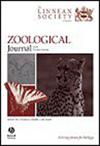蚜虫系统发育中线粒体、核基因组和共生体基因组之间的不一致:谁说的是真话?
IF 3
2区 生物学
Q1 ZOOLOGY
引用次数: 0
摘要
由于蚜虫(蚜科)作为害虫的重要性及其迷人的生物特征,人们对其进行了深入研究。尽管人们对蚜虫很感兴趣,但对这一昆虫家族的进化史却知之甚少。最近的系统进化分析产生了相互矛盾的拓扑结构,使我们对蚜虫性状进化的理解更加复杂。在这项工作中,我们旨在揭示蚜虫的骨干系统发育。我们对 87 个物种的部分和整个线粒体基因组进行了测序。此外,我们还对 95 个蚜虫物种的 42 个核基因位点进行了测序,并从蚜虫强制性内共生体 Buchnera aphidicola 的 12 个新基因组和 61 个已发表基因组中获取了 146 个基因。我们从这三个来源获得了一部分蚜虫物种的数据,从而有助于对它们的信号进行比较分析。我们的分析证实了大多数亚科的单系性,验证了当前的分类学分类。然而,在线粒体和核系统发育中,亚科之间的关系仍然存在争议。Buchnera 的拓扑结构已完全解析,但在深层进化尺度上与宿主系统发育不一致,并且与蚜虫形态进化的观点相冲突。我们讨论了造成这些差异的其他假设。最后,在深层时间尺度上缺乏系统发育信息可能源于最初的快速辐射。这种情况虽然难以确定,但可能从本质上阻碍了蚜虫系统发生学的解决。本文章由计算机程序翻译,如有差异,请以英文原文为准。
Discordance between mitochondrial, nuclear, and symbiont genomes in aphid phylogenetics: who is telling the truth?
Aphids (Aphididae) are intensively studied due to their significance as pests and their captivating biological traits. Despite this interest, the evolutionary history of this insect family is poorly understood. Recent phylogenomic analyses have produced conflicting topologies, complicating our understanding of aphid trait evolution. In this work, we aimed to unravel the backbone phylogeny of aphids. We sequenced partial and whole mitochondrial genomes from 87 species. We additionally sequenced 42 nuclear loci across 95 aphid species and sourced 146 genes from 12 new and 61 published genomes from aphid obligate endosymbiont, Buchnera aphidicola. We obtained data from these three sources for a subset of aphid species, facilitating a comparative analysis of their signal. Our analyses confirm the monophyly of most subfamilies, validating current taxonomic classifications. However, relationships between subfamilies remain contentious in both mitochondrial and nuclear phylogenies. The topologies obtained with Buchnera are fully resolved but disagree with host phylogenies at deep evolutionary scales and conflict with views on the evolution of aphid morphology. We discuss alternative hypotheses for these discrepancies. Finally, the paucity of phylogenetic information at deep timescales may stem from an initial rapid radiation. Though challenging to establish, this scenario may inherently hinder resolution in aphid phylogenetics.
求助全文
通过发布文献求助,成功后即可免费获取论文全文。
去求助
来源期刊
CiteScore
6.50
自引率
10.70%
发文量
116
审稿时长
6-12 weeks
期刊介绍:
The Zoological Journal of the Linnean Society publishes papers on systematic and evolutionary zoology and comparative, functional and other studies where relevant to these areas. Studies of extinct as well as living animals are included. Reviews are also published; these may be invited by the Editorial Board, but uninvited reviews may also be considered. The Zoological Journal also has a wide circulation amongst zoologists and although narrowly specialized papers are not excluded, potential authors should bear that readership in mind.

 求助内容:
求助内容: 应助结果提醒方式:
应助结果提醒方式:


